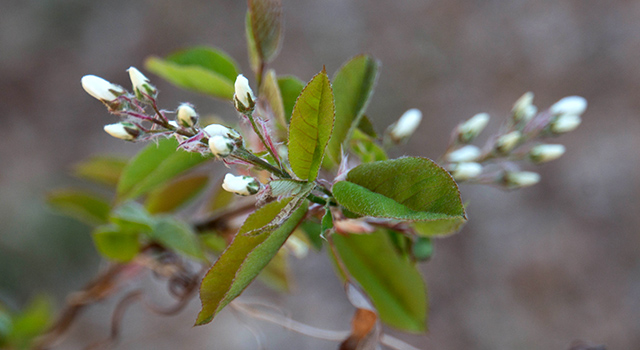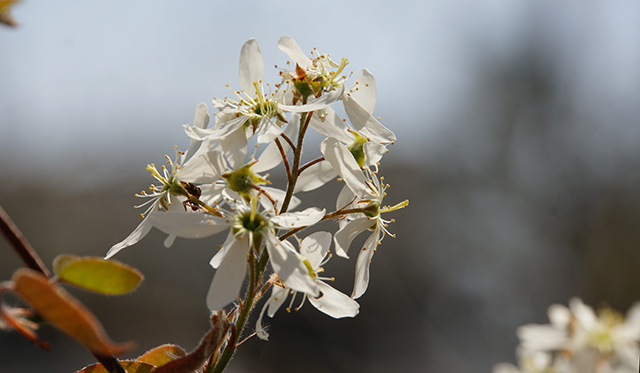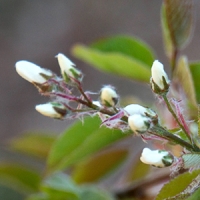An earlier than average warming event followed by another period of freezing temperatures is called a false spring. A stretch of warm, sunny weather will "trick" many plants into opening their buds early. The subsequent freezing temperatures can kill the young, sensitive, newly opened buds, setting the tree back significantly.
To understand the effects of a false spring, we need to understand the amount of work the tree has put in to preparing for winter.
Winter was Coming...
To really get into it read Overwintering Plants: Science and Practice, which details the process plants go through as winter approaches. Our sweet tree spent much of last summer and autumn preparing to survive a long, cold winter. Throughout the summer, it photosynthesized its little heart out, growing its branches taller and wider, and expanding its root system so that it could be ready to rock next spring. It pumped its living stem with all kinds of sugars and starches and mineral nutrients to sustain it through a long dormancy and through a flush of growth in the spring. And (miracle of miracles!) it set little leaf and flower buds along its stem, ready to open and resume growth when winter is over.

This serviceberry (Amelanchier laevis) spent its fall building buds packed with fully formed flowers in preparation of a coming spring.
Let’s look closer at those buds: the parts we can see on the outside are modified leaves called bud scales. These bud scales act as little shields, protecting what’s inside form the extremes of the oncoming winter weather. What’s inside the bud is a perfect, fully formed flower or leaf, folded and packed in, and waiting to grow.
Let me say that again: when we walk through the woods in the winter, and we see buds at the end of the twigs on trees, we are looking at fully formed leaves and flowers, packed in nature’s most elaborate origami. Leaves for next growing season, made last growing season.
Last summer, when our little tree was photosynthesizing as hard as it could, it put a significant portion of its resources towards making leaves and flowers that would wait, all set up and ready to grow. That way, in the spring, our tree can put its stored resources towards growing those leaves bigger, and forming the vascular (stem and root) tissue necessary to support them.
Spring has Sprung – Or has It?
The warm weather of a false spring causes our tree’s little buds to open and initiate a flush of growth. Then, all of a sudden, it’s below freezing again. Our tree is adapted to survive freezing temperatures when they come on very slowly and the tree has sufficient time for prepare. But our tree doesn’t do so well when those freezing temperatures come on in a day or two. The leaf and flower buds that have opened during the early, false spring, will most likely succumb to the freezing temperatures and die.
This setback most likely won’t kill our tree (unless it’s already under considerable stress), but in a month or two when real spring comes on, the tree will have to put its stored resources into re-forming all of those leaf and flower buds that it lost. Our tree will effectively be playing catch-up all growing season long. The setback may be extreme enough that the tree won’t be able to catch up enough to flower and fruit at all this season. It almost certainly will not be able to produce as many flowers and fruits as it does on normal years with no false spring.
These flower and fruit setbacks mean false springs can be devastating for agriculture. For example, the false spring of 2012 caused an estimated $500 million dollars of losses in the orchards of Michigan. The effects of a false spring can also cause a ripple effect through the ecosystem; in the growing season after a false spring, timing of vegetative growth, sap flow, and nectar and nutrient availability is altered, which affects the availability of shelter and food for wildlife.

Will our little serviceberry get the chance to flower this spring? Only time will tell!
One of the many benefits of native trees and shrubs is that they are less affected by a false spring than ornamental trees or food crops. They are acclimated to their environment , adapted to flush out a little later using photoperiod as a guide more than temperature. But even hardy natives aren't immune to the effects of repeated false spring events.
This summer, our sweet little tree will once again photosynthesize its little heart out. It will bounce back. But you may see fewer blossoms on trees around your neighborhood and fewer (or more expensive) fruits at the markets. What can we do this year to help? Other than a good layer of mulch, we can all strive this year to be nicer to our farmers, nicer to our trees, and nicer to our earth.





